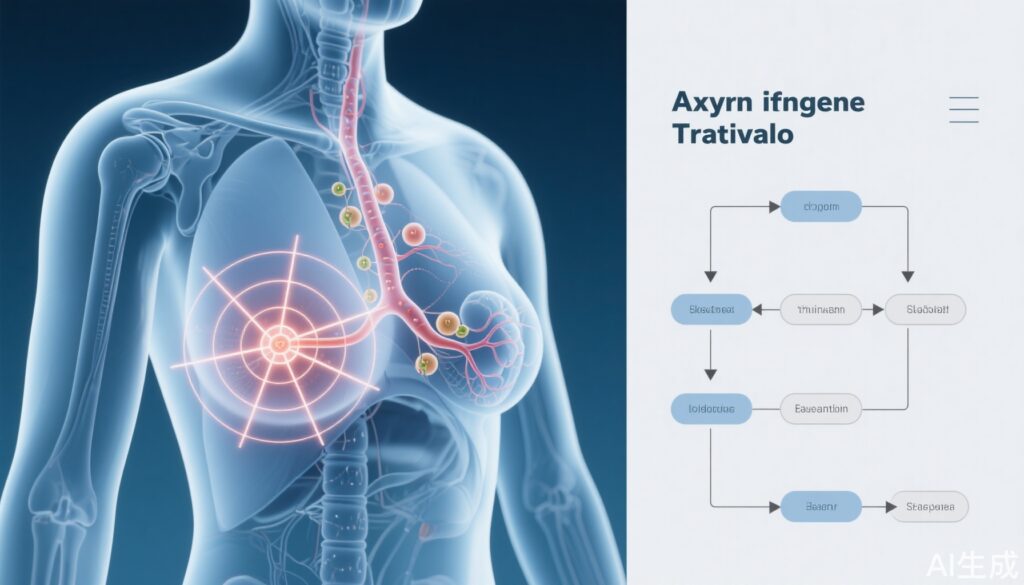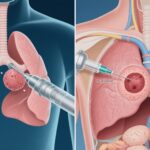Highlights
- Regional nodal irradiation (RNI) did not reduce invasive breast cancer recurrence or mortality in patients achieving ypN0 status after neoadjuvant chemotherapy.
- No significant differences in locoregional, distant recurrence, disease-free, or overall survival between RNI and no-RNI groups.
- RNI was associated with a low but slightly increased rate of serious adverse events.
- Findings support safely omitting RNI in this patient subset, potentially sparing unnecessary treatment toxicity.
Clinical Background and Disease Burden
Breast cancer remains a major global health challenge, with axillary lymph node involvement being a key prognostic factor and determinant of adjuvant therapy. Regional nodal irradiation (RNI)—targeting the axillary, supraclavicular, and internal mammary nodes—is standard for patients with pathologically positive axillary nodes, reducing locoregional recurrence and improving survival. However, with the increasing use of neoadjuvant chemotherapy (NAC), many initially node-positive patients achieve a pathological complete response in the axilla (ypN0). The clinical value of RNI in this subgroup is uncertain, as these patients may already have a favorable prognosis, and radiation carries risks of lymphedema, pneumonitis, and cardiac toxicity. Optimizing post-NAC management is a priority to balance efficacy with quality of life.
Research Methodology
The NSABP B-51/RTOG 1304 was a rigorously designed, randomized, phase III trial evaluating whether adjuvant RNI provides additional benefit in breast cancer patients with biopsy-proven node-positive disease who convert to ypN0 after NAC.
Key design features:
- Population: Women with clinical T1–T3, N1, M0 breast cancer (tumor size ≤2 cm to >5 cm, movable ipsilateral level I/II axillary nodes, no distant metastasis) who were ypN0 post-NAC.
- Intervention: Randomization to RNI (irradiation of regional lymph nodes) or no RNI after surgery.
- Primary Endpoint: Invasive breast cancer recurrence–free interval (time to recurrence or breast cancer-specific death).
- Secondary Endpoints: Locoregional and distant recurrence–free intervals, disease-free survival, overall survival, and safety.
- Enrollment: 1641 patients; 1556 included in efficacy analysis.
- Follow-up: Median 59.5 months.
Key Findings
The study yielded robust, practice-informing results:
- Primary outcome: 109 events occurred (50 RNI, 59 no-RNI). RNI did not significantly improve the invasive breast cancer recurrence–free interval (hazard ratio [HR] 0.88, 95% CI 0.60–1.28; P=0.51).
- Estimated 5-year recurrence-free survival: 92.7% (RNI) vs. 91.8% (no-RNI).
- No benefit for secondary endpoints: Locoregional recurrence–free interval, distant recurrence–free interval, disease-free survival, and overall survival were statistically similar between groups.
- Safety: No deaths attributed to protocol therapy. Grade 4 adverse events were rare (0.5% RNI vs. 0.1% no-RNI). No unexpected toxicities.
These findings indicate that for patients with initial node-positive disease who achieve ypN0 after NAC, the omission of adjuvant RNI does not compromise oncologic outcomes.
Mechanistic Insights and Biological Rationale
The biological plausibility of omitting RNI in ypN0 patients rests on the concept that effective NAC eradicates nodal tumor burden, rendering additional regional irradiation less impactful. Modern systemic therapies have improved pathological complete response rates, especially in triple-negative and HER2-positive subtypes, supporting individualized de-escalation strategies.
Expert Commentary
Leading breast cancer guidelines, including those from ASCO, ESMO, and NCCN, have historically recommended RNI for residual node-positive disease post-NAC. However, the current trial provides high-level evidence supporting the safe omission of RNI in patients with axillary pathological complete response—an approach that can spare patients from unnecessary treatment toxicity. As Dr. Eleftherios Mamounas, lead author, noted, “This trial provides reassurance to clinicians and patients that regional nodal irradiation can be omitted in selected patients without increasing the risk of recurrence or death.”
Controversies and Limitations
Some important considerations remain:
- Generalizability: Only patients with initial N1 disease who became ypN0 are addressed; the benefit in N2/N3 or patients with residual nodal disease is not established.
- Follow-up duration: Median follow-up of ~5 years is robust, but longer-term recurrence patterns, especially for hormone receptor–positive disease, warrant further observation.
- Subgroup analyses: Outcomes by molecular subtype (e.g., triple-negative vs. ER-positive) are not detailed in the summary but may inform future personalization.
- Radiation techniques: Contemporary delivery methods minimize toxicity, but resource availability may vary globally.
Conclusion
The NSABP B-51/RTOG 1304 trial fundamentally shifts the paradigm for post-NAC management of initially node-positive breast cancer. For patients achieving ypN0 status, omitting regional nodal irradiation is oncologically safe and avoids unnecessary toxicity. This evidence supports a de-escalation strategy, promoting patient-centered care and resource optimization. Ongoing research should clarify the role of RNI in other risk groups and with longer follow-up.
References
Mamounas EP, Bandos H, White JR, Julian TB, Khan AJ, Shaitelman SF, Torres MA, Vicini FA, Ganz PA, McCloskey SA, Lucas PC, Gupta N, Li XA, McCormick B, Smith B, Tendulkar RD, Kavadi VS, Matsumoto K, Seaward SA, Irvin WJ Jr, Lin JY, Mutter RW, Muanza TM, Stromberg J, Jagsi R, Weiss AC, Curran WJ Jr, Wolmark N. Omitting Regional Nodal Irradiation after Response to Neoadjuvant Chemotherapy. N Engl J Med. 2025 Jun 5;392(21):2113-2124. doi: 10.1056/NEJMoa2414859. PMID: 40466065; PMCID: PMC12269788.



